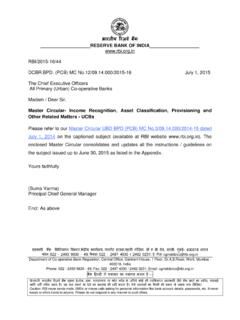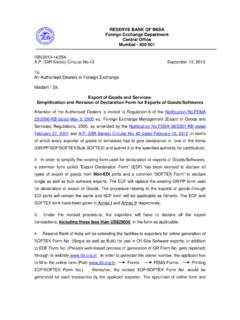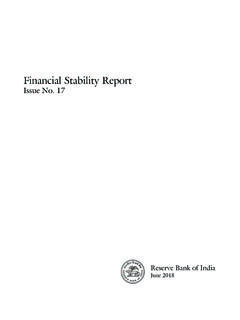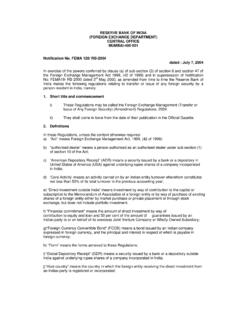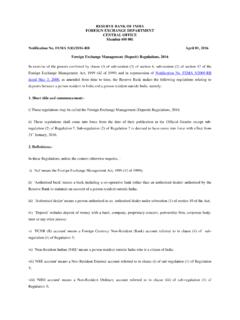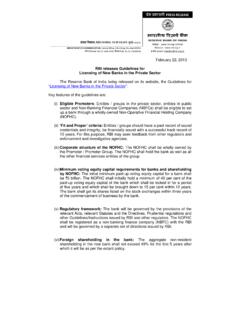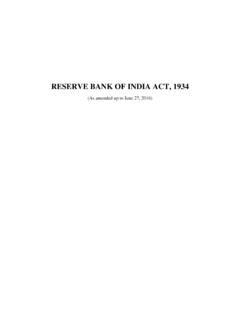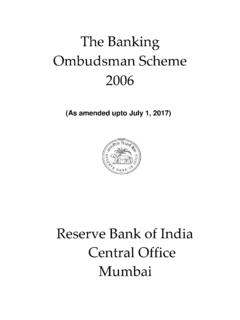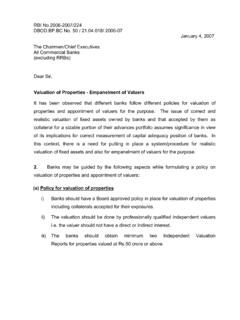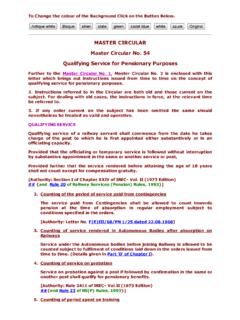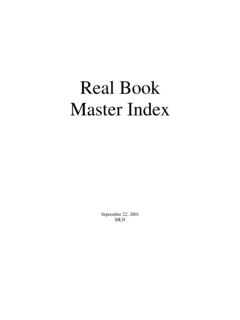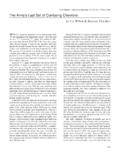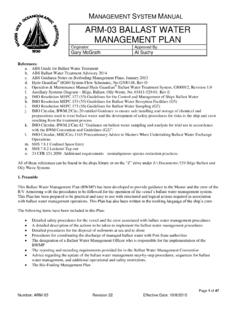Transcription of भारतीय रजवर् बक - RBI
1 _____RESERVE BANK OF INDIA _____ , 12 , , , , , , 400 001 Department of Banking Regulation, 12th Floor, RBI, Central Office Building, Shahid Bhagat Singh Marg, Fort, Mumbai 400 001 Tel No: 2260 1000 Fax No: 2270 5691 E-mail: RBI/2015-1 6/58 6 July 1, 2015 All Scheduled Commercial Banks (Excluding Local Area Banks and Regional Rural Banks) Madam / Sir, Master Circular Basel III Capital Regulations Please refer to the Master Circular 5 dated July 1, 2014, consolidating therein the prudential guidelines on capital adequacy issued to banks till June 30, 2014. 2. As you are aware, Basel III Capital Regulations are being implemented in India with effect from April 1, 2013 in a phased manner.
2 This Master Circular consolidates instructions on the above matters issued up to June 30, 2015. 3. The Basel II guidelines as contained in the Master Circular 4 6 dated July 1, 2015 on Prudential Guidelines on Capital Adequacy and Market Discipline- New Capital Adequacy Framework (NCAF) may, however, be referred to during the Basel III transition period for regulatory adjustments / deductions up to March 31, 2017. Yours faithfully, (Sudarshan Sen) Chief General Manager-in-Charge Encl.: As above - 2 - TABLE OF CONTENTS Part A : Minimum Capital Requirement (Pillar 1) 1 Introduction 2 Approach to Implementation and Effective Date 3 Scope of Application of Capital Adequacy Framework 4 Composition of Regulatory Capital General Elements and Criteria of Regulatory Capital Recognition of Minority Interests Regulatory Adjustments / Deductions Transitional Arrangements 5 Capital Charge for Credit Risk General Claims on Domestic Sovereigns Claims on Foreign Sovereigns Claims on Public Sector Entities(PSEs)
3 Claims on MDBs, BIS and IMF Claims on Banks Claims on Primary Dealers Claims on Corporates, AFCs & NBFC-IFCs Claims included in the Regulatory Retail Portfolios Claims secured by Residential Property Claims Classified as Commercial Real Estate Non-Performing Assets Specified Categories Other Assets Off-Balance Sheet Items General Non-Market-related Off-balance Sheet items Treatment of Total Counterparty Credit Risk Failed Transactions Securitisation Exposures General Treatment of Securitisation Exposures Implicit Support Application of External Ratings Risk-weighted Securitisation Exposures Off-balance Sheet Securitisation Exposures Recognition of Credit Risk Mitigants Liquidity Facilities Re-Securitisation Exposures/Synthetic Securitisation/ Securitisation with Revolving Structures (with or without early amortization features) Capital Adequacy Requirements for Credit Default Swaps (CDS)
4 Position in Banking Book Recognition of External/Third Party CDS Hedges Internal Hedges 6 External Credit Assessments Eligible Credit Rating Agencies Scope of Application of External Ratings - 3 - Mapping Process Long Term Ratings Short Term Ratings Use of Unsolicited Ratings Use of Multiple Rating Assessments Applicability of Issue rating to Issuer/other claims 7 Credit Risk Mitigation General Principles Legal Certainty Credit Risk Mitigation Techniques Collateralised Transactions Overall Framework and Minimum Conditions The Comprehensive Approach Eligible Financial Collateral Calculation of Capital Requirement Haircuts Capital Adequacy Framework for Repo-/Reverse Repo-style Transactions. Credit Risk Mitigation Techniques On balance Sheet netting Credit Risk Mitigation Techniques Guarantees Operational requirements for Guarantees Additional operational requirements for Guarantees Range of Eligible Guarantors (counter-guarantors)
5 Risk Weights Proportional Cover Currency Mismatches Sovereign Guarantees and Counter-guarantees ECGC Guaranteed Exposures Maturity Mismatch Treatment of pools of CRM Techniques 8 Capital Charge for Market Risk Introduction Scope and Coverage of Capital Charge for Market Risks Measurement of Capital Charge for Interest Rate Risk Measurement of Capital Charge for Equity Risk Measurement of Capital Charge for Foreign Exchange Risk Measurement of Capital Charge for CDS in Trading Book General Market Risk Specific Risk for Exposure to Reference Entity Capital Charge for Counterparty Credit Risk Treatment of Exposures below Materiality Thresholds of CDS Aggregation of the Capital Charge for Market Risk Treatment of illiquid positions 9 Capital charge for Operational Risk Definition of Operational Risk The Measurement Methodologies The Basic Indicator Approach Part B : Supervisory Review and Evaluation Process (Pillar 2) 10 Introduction to SREP under Pillar 2 11 Need for improved risk management 12 Guidelines for SREP of the RBI and the ICAAP of the Banks The Background - 4 - Conduct of the SREP by the RBI The Structural Aspects of the ICAAP Review of ICAAP Outcomes ICAAP to be an integral part of the Mgmt.
6 & Decision making Culture The Principle of Proportionality Regular independent review and validation ICAAP to be a Forward looking Process ICAAP to be a Risk-based Process ICAAP to include Stress Tests and Scenario Analysis Use of Capital Models for ICAAP 13 Select Operational Aspects of ICAAP Part C : Market Discipline (Pillar 3) 14 Guidelines on Market Discipline General Achieving Appropriate Disclosure Interaction with Accounting Disclosure Validation Materiality Proprietary and Confidential Information General Disclosure Principle Implementation Date Scope and Frequency of Disclosures Regulatory Disclosure Section Pillar 3 Under Basel III Framework The Post March 31, 2017 Disclosure Templates Template During Transition Period Reconciliation Requirements Disclosure Templates Table DF-1 Scope of Application and Capital Adequacy Table DF-2 Capital Adequacy Table DF-3 Credit Risk: General Disclosures for All Banks Table DF-4 Credit Risk: Disclosures for Portfolios subject to the Standardised Approach Table DF-5 Credit Risk Mitigation: Disclosures for Standardised Approach Table DF-6 Securitisation.
7 Disclosure for Standardised Approach Table DF-7 Market Risk in Trading Book Table DF-8 Operational Risk Table DF-9 Interest Rate Risk in the Banking Book (IRRBB) Table DF-10 General Disclosure for Exposures Related to Counterparty Credit Risk Table DF-11 Composition of Capital Table DF-12 Composition of Capital- Reconciliation Requirements Table DF-13 Main Features of Regulatory Capital Instruments Table DF-14 Full Terms and Conditions of Regulatory Capital Instruments Table DF-15 Disclosure Requirements for Remuneration Table DF-16 Equities Disclosure for Banking Book Positions Table DF-17 Summary Comparison of Accounting Assets vs. Leverage Ratio Exposure Measure - 5 - Table DF-18 Leverage Ratio Common Disclosure Template Part D : Capital Conservation Buffer Framework 15 Capital Conservation Buffer Objective The Framework Part E : Leverage Ratio Framework 16 Leverage Ratio Rationale and Objective Definition, Minimum Requirement and Scope of Application of the Leverage Ratio Capital Measure Exposure Measure General measurement principles On-balance sheet exposures Derivative exposures Securities financing transaction exposures Off-balance sheet items Transitional Arrangements Disclosure Requirements Disclosure Templates Part F.
8 Countercyclical Capital Buffer Framework 17 Countercyclical Capital Buffer Objective The Framework Annex Annex 1 Criteria for classification as Common Shares (paid-up equity capital) for regulatory purposes Indian Banks Annex 2 Criteria for classification as common equity for regulatory purposes Foreign Banks Annex 3 Criteria for inclusion of Perpetual Non-C umulative Preference Shares (PNCPS) in Additional Tier 1 capital Annex 4 Criteria for inclusion of Perpetual Debt Instruments (PDI) in Additional Tier 1 capital Annex 5 Criteria for inclusion of Debt Capital instruments as Tier 2 capital Annex 6 Criteria for inclusion of Perpetual Cumulative Preference Shares (PCPS)/ Redeemable Non-Cumulative Preference Shares (RNCPS) / Redeemable Cumulative Preference Shares (RCPS) as part of Tier 2 capital Annex 7 Prudential guidelines on Credit Default Swaps (CDS) Annex 8 Illustrations on Credit Risk Mitigation Annex 9 Measurement of capital charge for Market Risks in respect of Interest Rate Derivatives and Options.
9 Annex 10 An Illustrative Approach for Measurement of Interest Rate Risk in the Banking Book (IRRBB) under Pillar 2 Annex 11 Investments in the capital of banking, financial and insurance entities which are outside the scope of regulatory consolidation Annex 12 Illustration of transitional arrangements - capital instruments which no longer qualify as non-common equity Tier 1 capital or Tier 2 capital Annex 13 Calculation of CVA risk capital charge Annex 14 Calculation of SFT Exposure for the purpose of Leverage Ratio - 6 - Annex 15 An Illustrative outline of the ICAAP document Annex 16 Minimum requirements to ensure loss absorbency of Additional Tier 1 instruments at pre-specified trigger and of all non-equity regulatory capital instruments at the point of non-viability Annex 17 Calculation of minority interest - illustrative example Annex 18 Pillar 3 disclosure requirements Annex 19 Transitional arrangements for non-equity regulatory capital instruments Annex 20 Requirements for Recognition of Net Replacement
10 Cost in Close-out Netting Sets Annex 21 Glossary Annex 22 List of circulars consolidated Master Circular on Basel III Capital Regulations Part A: Guidelines on Minimum Capital Requirement 1. Introduction Basel III reforms are the response of Basel Committee on Banking Supervision (BCBS) to improve the banking sector s ability to absorb shocks arising from financial and economic stress, whatever the source, thus reducing the risk of spill over from the financial sector to the real economy. During Pittsburgh summit in September 2009, the G20 leaders committed to strengthen the regulatory system for banks and other financial firms and also act together to raise capital standards, to implement strong international compensation standards aimed at ending practices that lead to excessive risk-taking, to improve the over-the-counter derivatives market and to create more powerful tools to hold large global firms to account for the risks they take.
